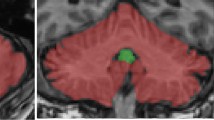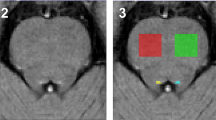Abstract
In this study, we aimed to determine the progression of brain atrophy in the parkinson variant of multiple system atrophy (MSA-P). Voxel-based morphometry was applied to two consecutive high resolution MR images of 14 patients with probable MSA-P in comparison to 14 patients with Parkinson’s disease (PD). The time interval between baseline and follow-up investigations (1.0 ± 0.5 SD years in MSA-P and 1.4 ± 0.6 SD years in PD patients) was introduced as covariate in the statistical analysis. Additionally, correlation analyses were performed between the progression maps and clinical data. We observed marked progression of brain atrophy in the MSA-P cohort, the regions including striatum, mesencephalon, thalamus and cerebellum, but also cortical regions such as the primary sensorimotor cortex, supplementary motor area, lateral premotor cortex, medial frontal gyrus, middle frontal gyrus, orbito-frontal cortex, insula, posterior parietal cortex and hippocampus. Short disease duration was correlated with progression of atrophy in the striatum whereas longer disease duration was correlated with increasing atrophy in the cortical areas and cerebellar hemispheres. The UPDRS-III score was not significantly correlated with any brain region. Our data suggest that cortical atrophy is prominent in MSA-P and early degeneration of the basal ganglia drives late onset cortical atrophy.



Similar content being viewed by others
Reference
Brenneis C, Boesch SM, Egger KE, Seppi K, Scherfler C, Schocke M, Wenning GK, Poewe W (2-2006) Cortical atrophy in the cerebellar variant of multiple system atrophy: A voxel-based morphometry study. Mov Disord 21(2):159–165
Brenneis C, Seppi K, Schocke MF, Muller J, Luginger E, Bosch S, Loscher WN, Buchel C, Poewe W, Wenning GK (2003) Voxel-based morphometry detects cortical atrophy in the Parkinson variant of multiple system atrophy. Mov Disord 18:1132–1138
Gilman S, Low PA, Quinn N, Albanese A, Ben Shlomo Y, Fowler CJ, Kaufmann H, Klockgether T, Lang AE, Lantos PL, Litvan I, Mathias CJ, Oliver E, Robertson D, Schatz I, Wenning GK (1-2-1999) Consensus statement on the diagnosis of multiple system atrophy. J Neurol Sci 163:94–98
Good CD, Johnsrude IS, Ashburner J, Henson RN, Friston KJ, Frackowiak RS (2001) A voxel-based morphometric study of ageing in 465 normal adult human brains. Neuroimage 14:21–36
Horimoto Y, Aiba I, Yasuda T, Ohkawa Y, Katayama T, Yokokawa Y, Goto A, Ito Y (2002) Longitudinal MRI study of multiple system atrophy - when do the findings appear, and what is the course? J Neurol 249:847–854
Hughes AJ, Daniel SE, Kilford L, Lees AJ (1992) Accuracy of clinical diagnosis of idiopathic Parkinson’s disease: a clinico-pathological study of 100 cases. J Neurol Neurosurg Psychiatry 55:181–184
Klockgether T, Faiss J, Poremba M, Dichgans J (1990) The development of infratentorial atrophy in patients with idiopathic cerebellar ataxia of late onset: a CT study. J Neurol 237:420–423
Konagaya M, Konagaya Y, Sakai M, Matsuoka Y, Hashizume Y (30–3-2002) Progressive cerebral atrophy in multiple system atrophy. J Neurol Sci 195:123–127
Konagaya M, Sakai M, Matsuoka Y, Konagaya Y, Hashizume Y (1999) Multiple system atrophy with remarkable frontal lobe atrophy. Acta Neuropathol (Berl) 97:423–428
Lantos PL (1998) The definition of multiple system atrophy: a review of recent developments. J Neuropathol Exp Neurol 57:1099–1111
Ozawa T, Paviour D, Quinn NP, Josephs KA, Sangha H, Kilford L, Healy DG, Wood NW, Lees AJ, Holton JL, Revesz T (2004) The spectrum of pathological involvement of the striatonigral and olivopontocerebellar systems in multiple system atrophy: clinicopathological correlations. Brain 127:2657–2671
Robbins TW, James M, Lange KW, Owen AM, Quinn NP, Marsden CD (1992) Cognitive performance in multiple system atrophy. Brain 115(Pt 1):271–291
Robbins TW, James M, Owen AM, Lange KW, Lees AJ, Leigh PN, Marsden CD, Quinn NP, Summers BA (1994) Cognitive deficits in progressive supranuclear palsy, Parkinson’s disease, and multiple system atrophy in tests sensitive to frontal lobe dysfunction. J Neurol Neurosurg Psychiatry 57:79–88
Seppi K, Yekhlef F, Diem A, Luginger, Wolf E, Mueller J, Tison F, Quinn NP, Poewe W, Wenning GK (2005) Progression of parkinsonism in multiple system atrophy. J Neurol 252:91–96
Su M, Yoshida Y, Hirata Y, Watahiki Y, Nagata K (2001) Primary involvement of the motor area in association with the nigrostriatal pathway in multiple system atrophy: neuropathological and morphometric evaluations. Acta Neuropathol (Berl) 101:57–64
Tison F, Yekhlef F, Chrysostome V, Balestre E, Quinn NP, Poewe W, Wenning GK (2002) Parkinsonism in multiple system atrophy: natural history, severity (UPDRS-III), and disability assessment compared with Parkinson’s disease. Mov Disord 17:701–709
Tsuchiya K, Ozawa E, Haga C, Watabiki S, Ikeda M, Sano M, Ooe K, Taki K, Ikeda K (2000) Constant involvement of the Betz cells and pyramidal tract in multiple system atrophy: a clinicopathological study of seven autopsy cases. Acta Neuropathol (Berl) 99:628–636
Watanabe H, Saito Y, Terao S, Ando T, Kachi T, Mukai E, Aiba I, Abe Y, Tamakoshi A, Doyu M, Hirayama M, Sobue G (2002) Progression and prognosis in multiple system atrophy: An analysis of 230 Japanese patients. Brain 125:1070–1083
Wenning GK, Ben Shlomo Y, Magalhaes M, Daniel SE, Quinn NP (1994) Clinical features and natural history of multiple system atrophy. An analysis of 100 cases. Brain 117(Pt 4):835–845
Wenning GK, Kraft E, Beck R, Fowler CJ, Mathias CJ, Quinn NP, Harding AE (1997) Cerebellar presentation of multiple system atrophy. Mov Disord 12:115–117
Wenning GK, Seppi K, Tison F, Jellinger K (2002) A novel grading scale for striatonigral degeneration (multiple system atrophy). J Neural Transm 109:307–320
Wenning GK, Ben-Shlomo V, Magalhäes M, Daniel SE, Quinn NP (1994) Clinical features and natural history of multiple system atrophy. Brain 117:835–845
Wenning GK, Tison F, Ben-Shlomo Y, Daniel SE, Quinn NP (1997) Multiple system atrophy: a review of 203 pathologically proven cases. Mov Disord 12:133–147
Author information
Authors and Affiliations
Corresponding author
Additional information
Received in revised form: 7 June 2006
Rights and permissions
About this article
Cite this article
Brenneis, C., Egger, K., Scherfler, C. et al. Progression of brain atrophy in multiple system atrophy. J Neurol 254, 191–196 (2007). https://doi.org/10.1007/s00415-006-0325-6
Received:
Accepted:
Published:
Issue Date:
DOI: https://doi.org/10.1007/s00415-006-0325-6




